The Effect of ZrO2 Nanoparticles on the Microstructure and Properties of Sintered WC–Bronze-Based Diamond Composites
Abstract
:1. Introduction
2. Materials and Methods
2.1. Sample Preparing
2.2. Characterization
3. Results and Discussion
3.1. Compositions and Microstructures
3.2. Mechanical Properties
3.3. Wear Resistance
4. Conclusions
Acknowledgments
Author Contributions
Conflicts of Interest
References
- Sun, L.; Pan, J.S.; Lin, C.J. A new approach to improve the performance of diamond sawblades. Mater. Lett. 2002, 57, 1010–1014. [Google Scholar] [CrossRef]
- Boland, J.N.; Li, X.S. Microstructural characterisation and wear behaviour of diamond composite materials. Materials 2010, 3, 1390–1419. [Google Scholar] [CrossRef]
- Sun, Y.C.; Liu, Y.B. Diamond Tool and Metallurgical Technology; China Construction Materials Press: Beijing, China, 1999. [Google Scholar]
- Ronald, B.A.; Vijayaraghavan, L.; Krishnamurthy, R. Studies on the influence of grinding wheel bond material on the grindability of metal matrix composites. Mater. Des. 2009, 30, 679–686. [Google Scholar] [CrossRef]
- Konstanty, J. Theoretical analysis of stone sawing with diamonds. J. Mater. Process. Technol. 2002, 123, 146–154. [Google Scholar] [CrossRef]
- Di Ilio, A.; Togna, A. A theoretical wear model for diamond tools in stone cutting. Int. J. Mach. Tools Manuf. 2003, 43, 1171–1177. [Google Scholar] [CrossRef]
- Webb, S.W. Diamond retention in sintered cobalt bonds for stone cutting and drilling. Diam. Relat. Mater. 1999, 8, 2043–2052. [Google Scholar] [CrossRef]
- Levashov, E.; Kurbatkina, V.; Alexandr, Z. Improved mechanical and tribological properties of metal-matrix composites dispersion-strengthened by nanoparticles. Materials 2009, 3, 97–109. [Google Scholar] [CrossRef]
- Spriano, S.; Chen, Q.; Settineri, L.; Bugliosi, S. Low content and free cobalt matrixes for diamond tools. Wear 2005, 259, 1190–1196. [Google Scholar] [CrossRef]
- Zhou, Y.M.; Zhang, F.L.; Wang, C.Y. Effect of Ni-Al SHS reaction on diamond grit for fabrication of diamond tool material. Int. J. Refract. Met. Hard Mater. 2010, 28, 416–423. [Google Scholar] [CrossRef]
- Hsieh, Y.Z.; Lin, S.T. Diamond tool bits with iron alloys as the binding matrices. Mater. Chem. Phys. 2001, 72, 121–125. [Google Scholar] [CrossRef]
- Casati, R.; Vedani, M. Metal matrix composites reinforced by nanoparticles—A review. Metals 2014, 4, 65–83. [Google Scholar] [CrossRef]
- Bakshi, S.R.; Lahiri, D.; Agarwal, A. Carbon nanotube reinforced metal matrix composites—A review. Int. Mater. Rev. 2010, 55, 41–64. [Google Scholar] [CrossRef]
- Tjong, S.C. Novel nanoparticle-reinforced metal matrix composites with enhanced mechanical properties. Adv. Eng. Mater. 2007, 9, 639–652. [Google Scholar] [CrossRef]
- Dorri Moghadam, A.; Schultz, B.F.; Ferguson, J.B.; Omrani, E.; Rohatgi, P.K.; Gupta, N. Functional metal matrix composites: Self-lubricating, self-healing, and nanocomposites—An outlook. JOM 2014, 66, 872–881. [Google Scholar] [CrossRef]
- Dorri Moghadam, A.; Omrani, E.; Menezes, P.L.; Rohatgi, P.K. Effect of in-situ processing parameters on the mechanical and tribological properties of self-lubricating hybrid aluminum nanocomposites. Tribol. Lett. 2016, 62. [Google Scholar] [CrossRef]
- Shash, A.Y.; Amer, A.E.; El-Mahallawi, I.S.; El-Saeed, M.A. The effect of process parameters on the mechanical properties of A356 Al-alloy/ZrO2 nanocomposite. J. Nano Res. 2016, 38, 1–8. [Google Scholar] [CrossRef]
- Zhang, Z.; Chen, D.L. Consideration of Orowan strengthening effect in particulate-reinforced metal matrix nanocomposites: A model for predicting their yield strength. Scr. Mater. 2006, 54, 1321–1326. [Google Scholar] [CrossRef]
- Zhang, Z.; Chen, D.L. Contribution of Orowan strengthening effect in particulate-reinforced metal matrix nanocomposites. Mater. Sci. Eng. A 2008, 483–484, 148–152. [Google Scholar] [CrossRef]
- Loginov, P.; Mishnaevsky, L.; Levashov, E.; Petrzhik, M. Diamond and cBN hybrid and nanomodified cutting tools with enhanced performance: Development, testing and modelling. Mater. Des. 2015, 88, 310–319. [Google Scholar] [CrossRef] [Green Version]
- Li, M.; Sun, Y.H.; Dong, B.; Wu, H.D.; Gao, K. Study on effects of CNTs on the properties of WC-based impregnated diamond matrix composites. Mater. Res. Innov. 2015, 19, 59–63. [Google Scholar] [CrossRef]
- He, Z.M.; Stiewe, C.; Platzek, D.; Karpinski, G.; Muller, E.; Li, S.H.; Toprak, M.; Muhammed, M. Effect of ceramic dispersion on thermoelectric properties of nano-ZrO2/CoSb3 composites. J. Appl. Phys. 2007, 101, 043707. [Google Scholar] [CrossRef]
- El-Mahallawi, I.S.; Shash, A.Y.; Amer, A.E. Nanoreinforced cast Al-Si alloys with Al2O3, TiO2 and ZrO2 nanoparticles. Metals 2015, 5, 802–821. [Google Scholar] [CrossRef]
- Ma, Y.L.; Sun, Y.H.; Gao, K.; Liu, B.C.; Zhang, X.Z.; Li, X.Y. Experiment on WC matrix composites performance prepared by hot pressing sintering. J. Jilin Univ. (Earth Sci. Ed.) 2013, 43, 207–211. [Google Scholar]
- Wang, Z.; Zhang, Z.; Sun, Y.; Gao, K.; Liang, Y.; Li, X.; Ren, L. Wear behavior of bionic impregnated diamond bits. Tribol. Int. 2016, 94, 217–222. [Google Scholar] [CrossRef]
- Mishra, M.; Kuppusami, P.; Murugesan, S.; Ghosh, C.; Divakar, R.; Singh, A.; Mohandas, E. Thermal stability and thermal expansion behaviour of ZrO2/Y2O3 multilayers deposited by pulsed laser deposition technique. Mater. Chem. Phys. 2015, 162, 592–607. [Google Scholar] [CrossRef]
- Vaidya, R.U.; Chawla, K.K. Thermal expansion of metal-matrix composites. Compos. Sci. Technol. 1994, 50, 13–22. [Google Scholar] [CrossRef]
- Howe, J.M. Bonding, structure, and properties of metal/ceramic interfaces: Part 1 Chemical bonding, chemical reaction, and interfacial structure. Int. Mater. Rev. 1993, 38, 233–256. [Google Scholar] [CrossRef]
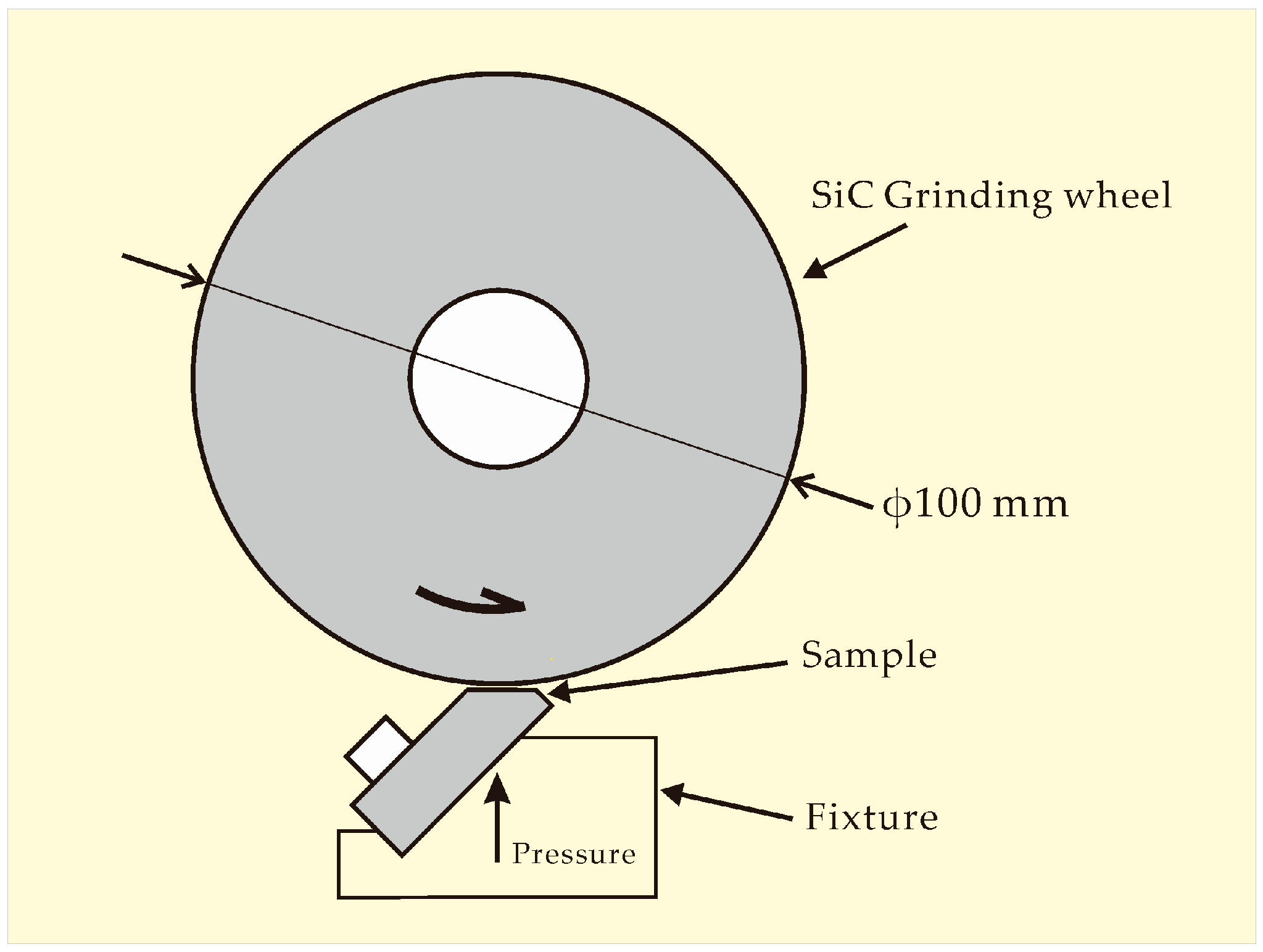
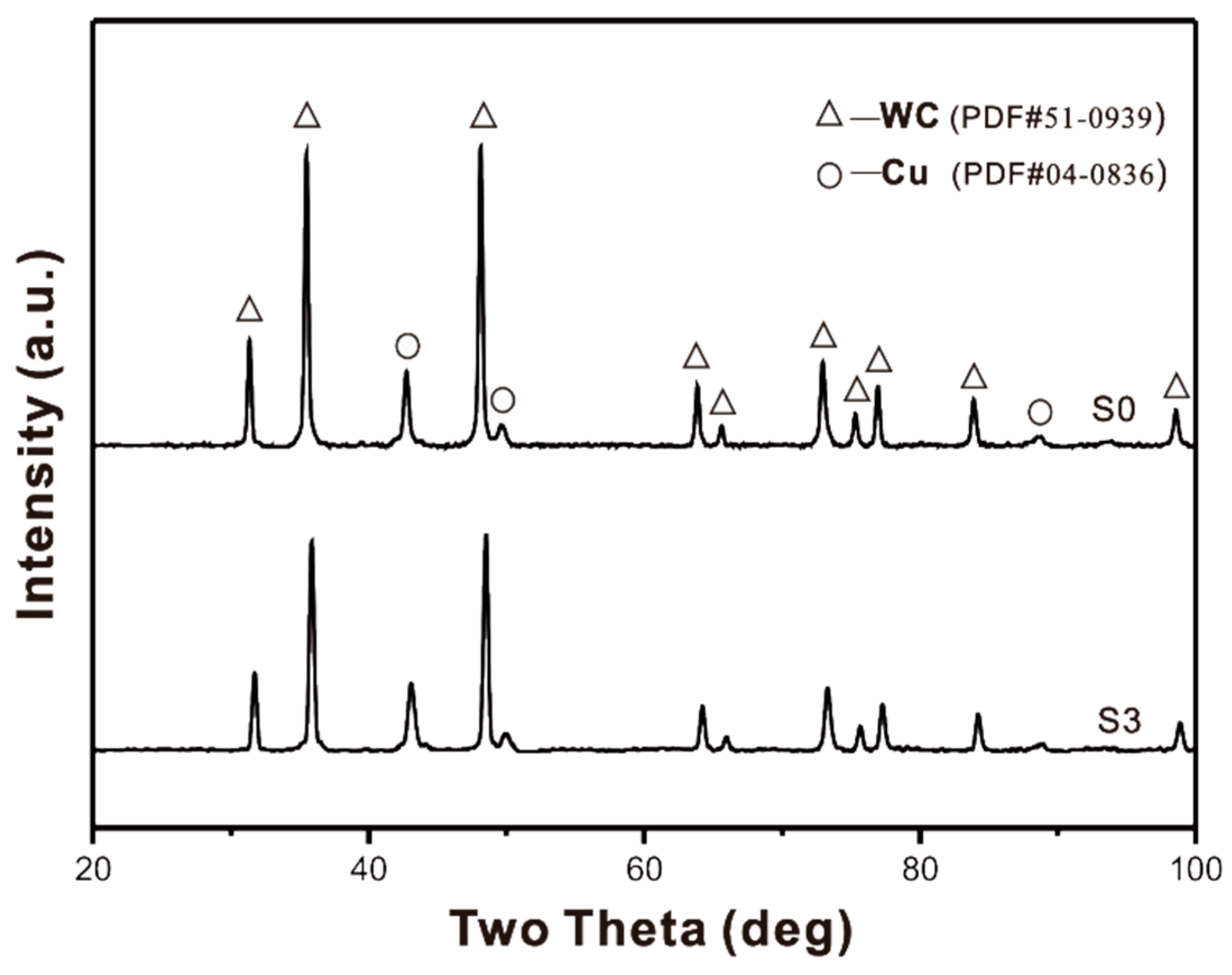
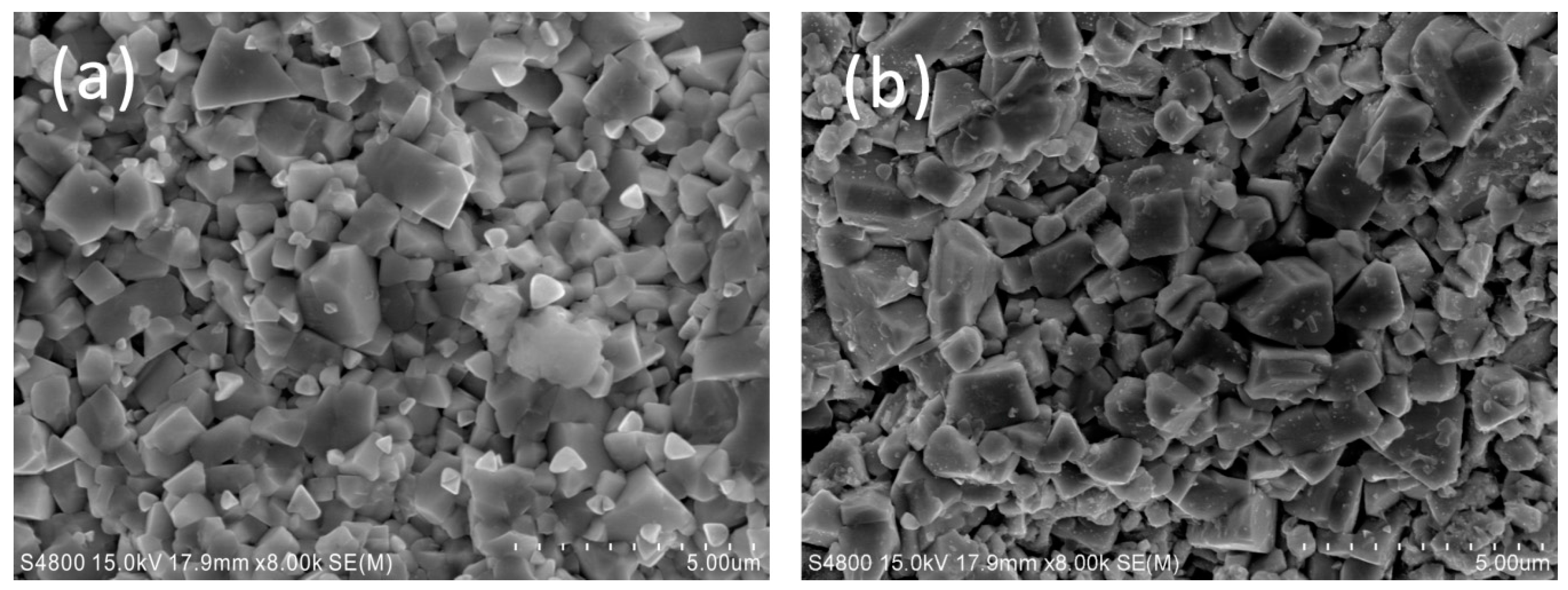
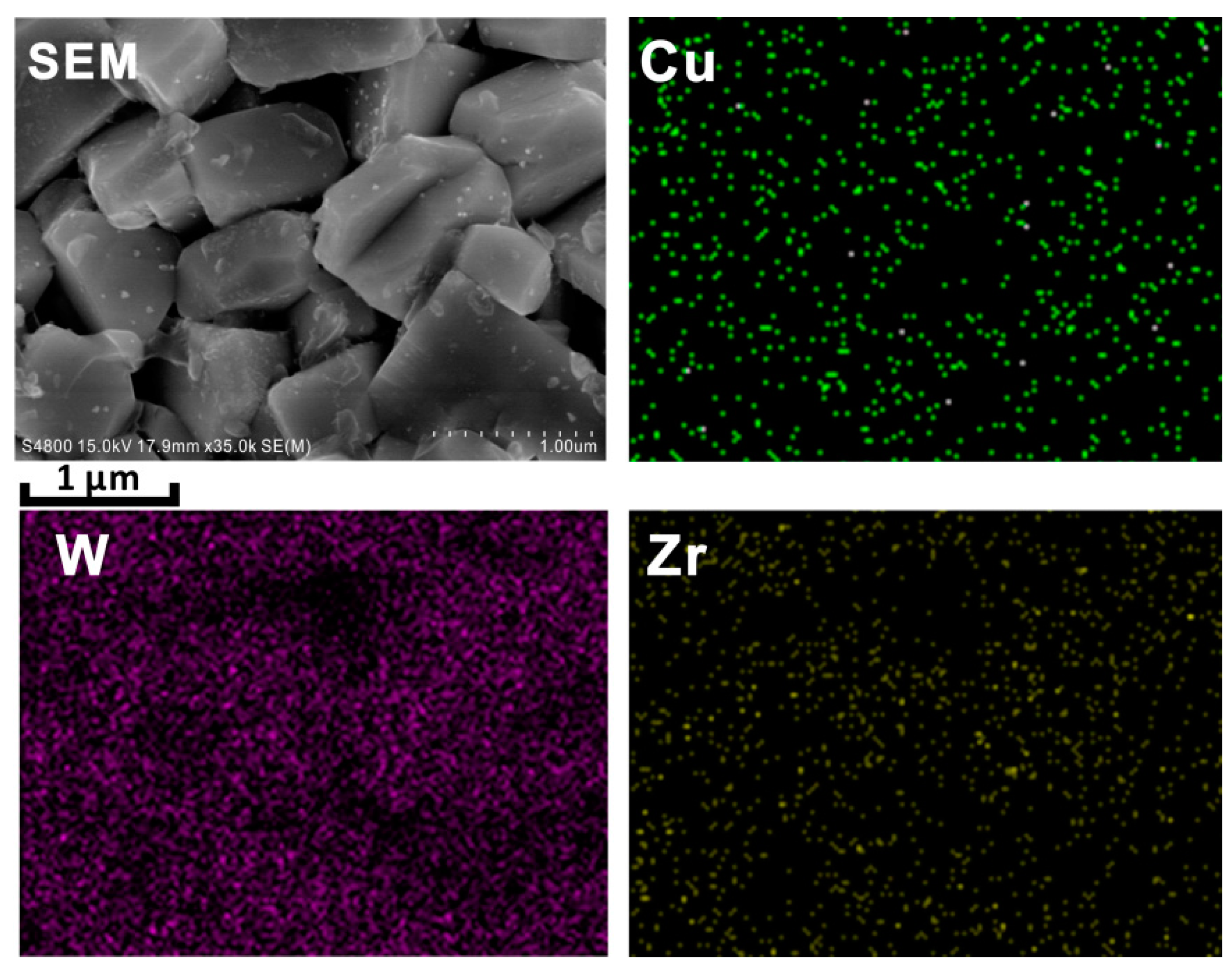
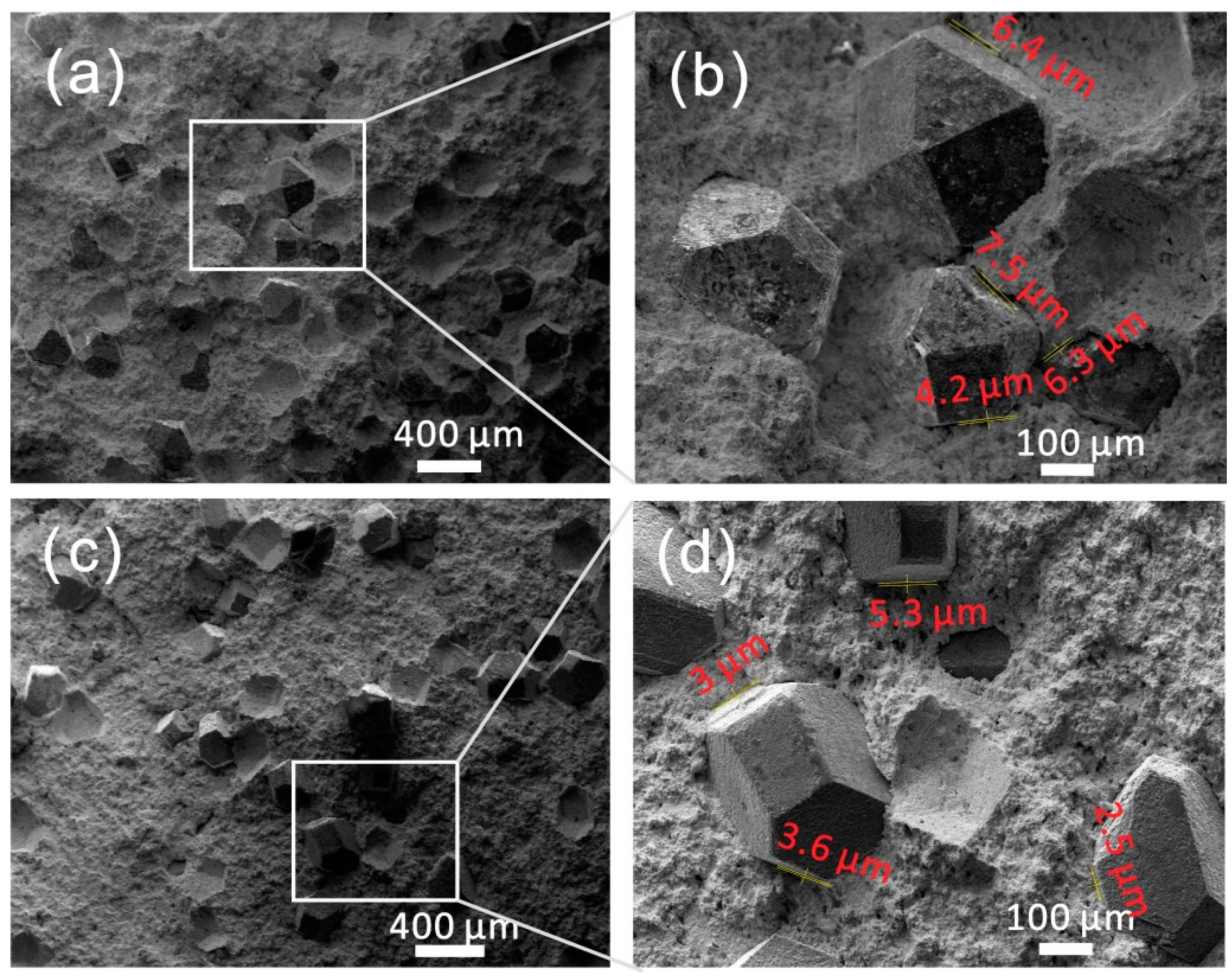
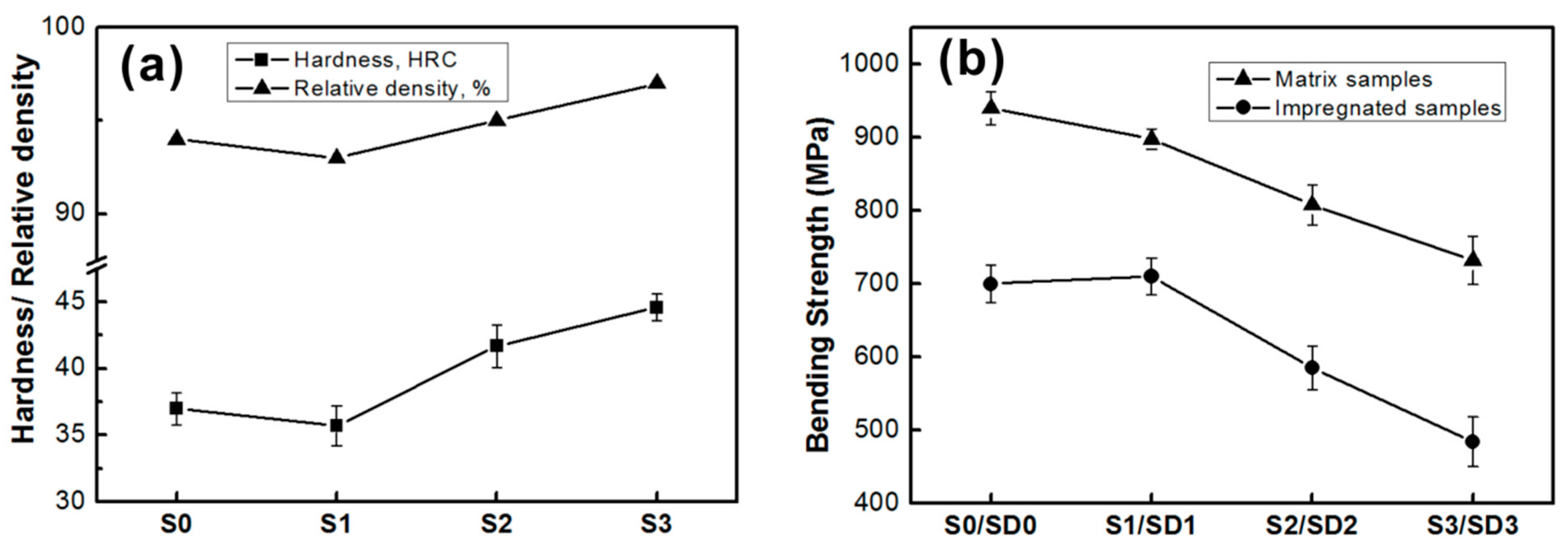
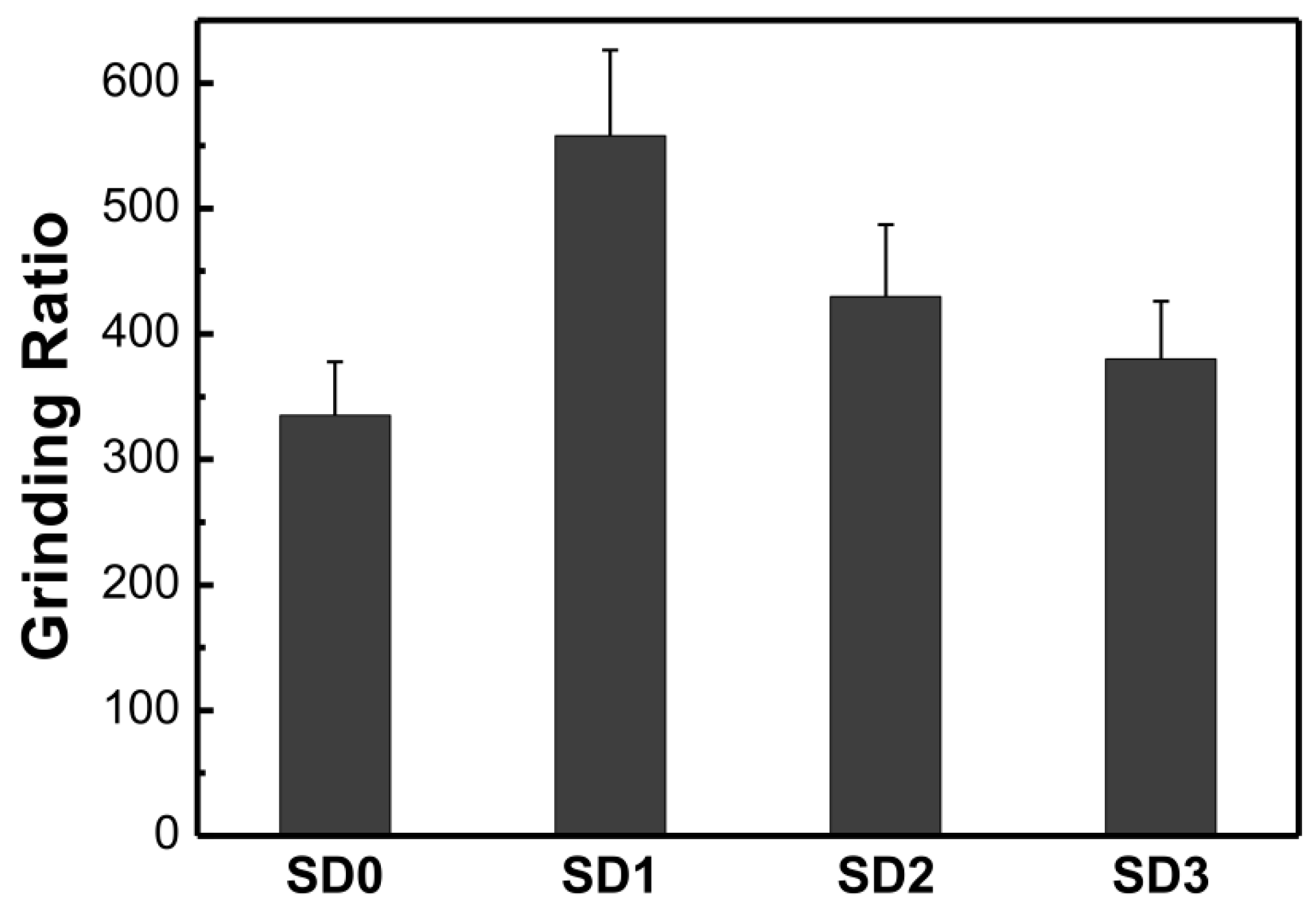
| Samples | Composition | Relative Density (%) | Hardness (HRC) | Bending Strength (MPa) |
|---|---|---|---|---|
| S0 | Matrix | 94 | 37.0 ± 1.2 | 940 ± 23 |
| S1 | Matrix + 1 wt % nano-ZrO2 | 93 | 35.7 ± 1.5 | 898 ± 14 |
| S2 | Matrix + 2 wt % nano-ZrO2 | 95 | 41.7 ± 1.6 | 808 ± 27 |
| S3 | Matrix + 3 wt % nano-ZrO2 | 97 | 44.6 ± 1.0 | 732 ± 33 |
| SD0 | Matrix + diamond | 95 | - | 700 ± 26 |
| SD1 | Matrix + diamond + 1 wt % nano-ZrO2 | 96 | - | 710 ± 25 |
| SD2 | Matrix + diamond + 2 wt % nano-ZrO2 | 96 | - | 585 ± 30 |
| SD3 | Matrix + diamond + 3 wt % nano-ZrO2 | 97 | - | 484 ± 34 |
© 2016 by the authors; licensee MDPI, Basel, Switzerland. This article is an open access article distributed under the terms and conditions of the Creative Commons Attribution (CC-BY) license (http://creativecommons.org/licenses/by/4.0/).
Share and Cite
Sun, Y.; Wu, H.; Li, M.; Meng, Q.; Gao, K.; Lü, X.; Liu, B. The Effect of ZrO2 Nanoparticles on the Microstructure and Properties of Sintered WC–Bronze-Based Diamond Composites. Materials 2016, 9, 343. https://doi.org/10.3390/ma9050343
Sun Y, Wu H, Li M, Meng Q, Gao K, Lü X, Liu B. The Effect of ZrO2 Nanoparticles on the Microstructure and Properties of Sintered WC–Bronze-Based Diamond Composites. Materials. 2016; 9(5):343. https://doi.org/10.3390/ma9050343
Chicago/Turabian StyleSun, Youhong, Haidong Wu, Meng Li, Qingnan Meng, Ke Gao, Xiaoshu Lü, and Baochang Liu. 2016. "The Effect of ZrO2 Nanoparticles on the Microstructure and Properties of Sintered WC–Bronze-Based Diamond Composites" Materials 9, no. 5: 343. https://doi.org/10.3390/ma9050343






